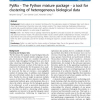3607 search results - page 712 / 722 » Learning with structured sparsity |
108
Voted
BIOINFORMATICS
2007
14 years 11 months ago
2007
Motivation: Protein–protein complexes are known to play key roles in many cellular processes. However, they are often not accessible to experimental study because of their low s...
125
Voted
BMCBI
2010
14 years 11 months ago
2010
Background: Cluster analysis is an important technique for the exploratory analysis of biological data. Such data is often high-dimensional, inherently noisy and contains outliers...
122
click to vote
BMCBI
2010
14 years 11 months ago
2010
Background: Minimotifs are short peptide sequences within one protein, which are recognized by other proteins or molecules. While there are now several minimotif databases, they a...
BMCBI
2010
14 years 11 months ago
2010
Background: Nonnegative Matrix Factorization (NMF) is an unsupervised learning technique that has been applied successfully in several fields, including signal processing, face re...
BMCBI
2008
14 years 11 months ago
2008
The G-protein coupled receptor (GPCR) superfamily is currently the largest class of therapeutic targets. In silico prediction of interactions between GPCRs and small molecules is ...

